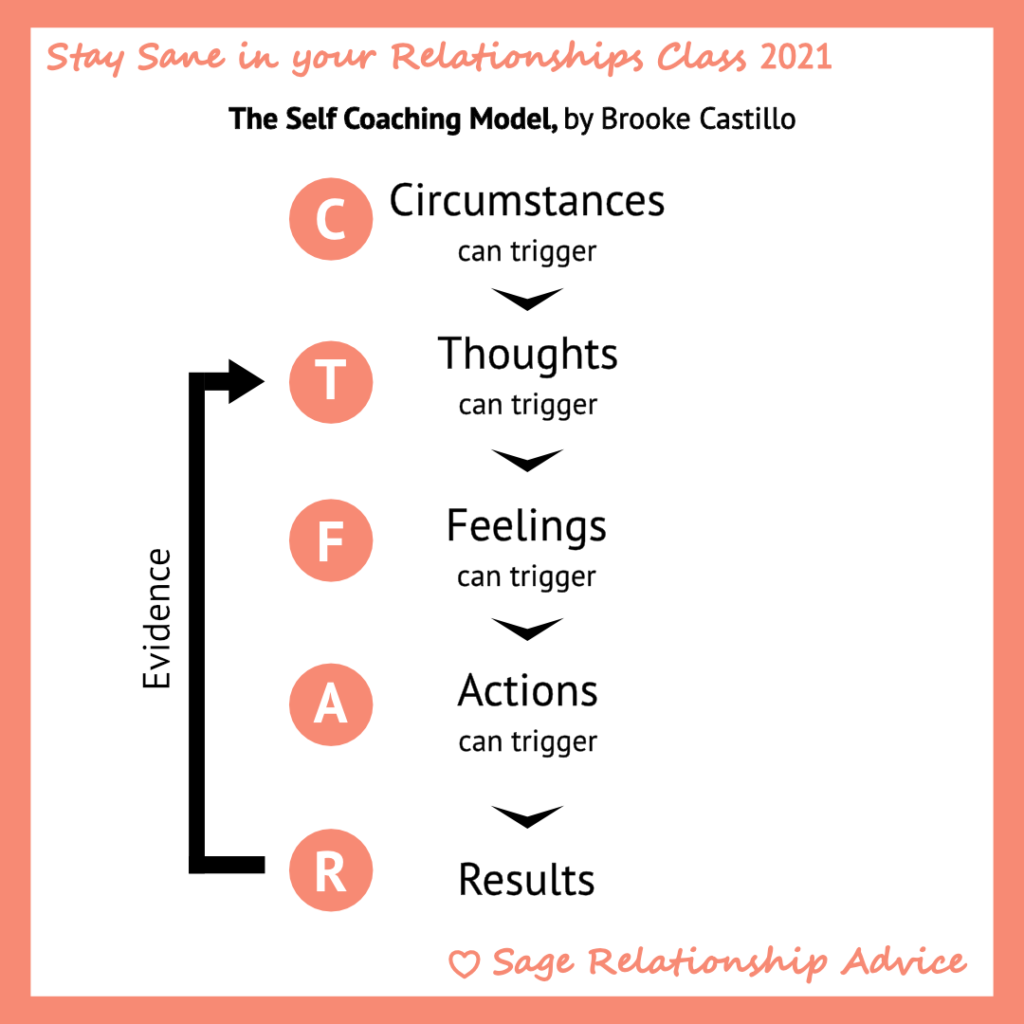This week, we are going even deeper into the first principle of good relationships: Focus on what you can control. Let’s review again, what can we control?

We can only control our thoughts, feelings, actions and personal results. We cannot control what someone else thinks, feels, or does. So remember to spend most of your energy focused on what you can control: yourself!
If we take a look at the self-coaching model (pictured below), we are reminded again that the only thing we cannot control is our circumstances. Our circumstances are the things that happen outside of us – what people say or do, etc. A circumstance is something that can be proven in court (for example: his hair is brown, she said this quote, this happened on this date). Everything below the circumstance line in the model (our thoughts, feelings, and actions) is in our control. We cannot control what other people do, but we can control how we react to it. We cannot control the weather, but we can control how we think about the weather.
The Self Coaching Model by Brooke Castillo

But how do you actually control your thoughts?
Now, many people don’t feel like they have much control over their thoughts. Thoughts happen so quickly, an estimated 50,000 thoughts a day, and most people never think to try and control them. I certainly thought it was too hard to control my thoughts until about a year ago. Sometimes my thoughts would run wild and spiral downward into increased negativity and depression. How could I have any control over that?
The Self-Coaching Model by Brooke Castillo helped me to start getting a handle on my thoughts. She taught me that my thoughts create my feelings. Try it – if you think “My life is horrible” (and you actually believe the thought), what emotion do you feel? Every thought creates a feeling. Once you realize this, it can help you slow down your thoughts a little bit. Next time you are feeling bad or happy, try to ask yourself: what thought is creating this feeling?
The next step to this model is to realize that our feelings often drive our actions. For example, if you are feeling creative, what do you want to do? Paint, write a book, create something! What if you are feeling depressed? Usually I want to eat something sweet or watch TV or scroll facebook. What actions do you take if you are feeling sad? All of our feelings can affect what we want to do with our time. So our feelings are important; our feelings drive a lot of our actions and inactions.
And if our thoughts are creating our feelings, then it is really our thoughts that are driving a lot of our actions or inactions. So being aware and careful of the thoughts we think is very important!
Examples
Let’s look at some examples.
Let’s say you want to have kinder feelings towards your roommate or spouse. Well, let’s first look at what you are currently thinking about them. Write down all your thoughts about them. Then look at them with an unbiased, nonjudgemental eye. Are these thoughts true facts or just thoughts? (Remember that a circumstance is a fact that can be proven in court. So everything that is not a fact, is a thought. Even if most people would agree that “this is a difficult person”, it is still a thought because it cannot be proven in court).
So, once you write down all your thoughts about this person, simply put one of the thoughts into the self coaching model to see what it is producing for you.
So let’s say your main thought about your spouse is “I’m not important to them.”
CIRCUMSTANCE: Your spouse looks at their phone for one hour after the kids go to bed instead of talking to you.
THOUGHT: “I’m not important to them.”
FEELING: (How do you feel when you think the above thought?) Sad
ACTION: (What do you do when you are feeling sad?) Maybe you think about how they should spend more time with you. Maybe you get angry. Maybe you avoid them too. When you do talk to them, it is with a disappointed tone of voice.
RESULT: Your result is that you don’t show up in a way that shows you are important to you.
If you want more examples about how to use the self coaching model, look at this article –
This article can also be helpful as you try to explore all the different parts of the self coaching model.
After you put one of your thoughts into the self coaching model and see what it is creating for you, ask yourself this question: Are there any other thoughts you could think that are a little more positive? Try on some new thoughts until you find one that you could maybe believe. Some of these new thoughts might be:
- “He/She is doing the best they can.”
- “Maybe this person is here to teach me something.”
- What is more important – getting this thing done or helping this person feel loved today?
Play around with thinking these new thoughts about that person and be amazed at how your experience of them can change drastically!
You can also work backwards through the model and first start with the emotion. What kind of feeling do you want towards this person? What sort of thoughts do you need to think to feel that way?
Ways to gain greater control over your thoughts:
- Being aware of your thoughts during the day
- Writing down your thoughts at the end of the day and trying to see what tweeks or changes you can make to your thoughts
- Practice thinking a new thought for 10 minutes a day
- Meditation
- Yoga
- Simply bat away negative thoughts like flies. Don’t pay too much attention to them. Focus your attention on your positive thoughts.
- Be aware of mood changes. When you are in a low mood, everything looks awful and nothing is going right. When you are in a high mood, no one can make you angry because you are so happy! So, when you are in a low mood, don’t try to evaluate your life and fix everything. Just remember that you will soon feel better and have compassion on yourself when you are feeling down.
Since our thoughts create our feelings and actions and results, then getting greater control over our thoughts will mean getting greater control over our lives.
How to gain greater control over your feelings:
Sometimes our feelings can overpower us. They can drive us to do something rash or they can keep us stuck in the same cycle that we are creating over and over again. How do we gain greater control over our feelings and emotions? Therapists and life coaches all agree – the easiest way to harness feelings is to FEEL them. You have to go through the feeling. A lot of us don’t want to feel negative emotion. We push it away and we don’t want to feel it. But if you just sit there for 30 seconds and FEEL sadness or frustration or anger or hurt, you will find that it isn’t that bad. I’ll show you how.
To feel/process an emotion, here are a few steps you can try:
- Try to pinpoint what the emotion feels like in the body. (For example, sadness might feel like a lump in the stomach and a tightness in the throat).
- Label the emotion. Tell yourself: “This is sadness.”
- Relax into the feeling. Take several deep breathes and just feel the sadness for a minute or two.
When I do this, the feeling usually subsides after a minute or two. Emotions are there to let us know something is going on. When we resist feeling an emotion, it only gets bigger and more uncontrolable.
I think most people try to resist feeling negative emotion. What do you do when you feel sad? Sometimes I like to eat, other times I want to distract myself by watching Netflix or scrolling Facebook or Instagram. Rarely do I want to just FEEL the sadness for a few minutes. But feeling that emotion (or processing it) is exactly how you will be able to get over it.
If you take time to feel your negative emotions more often, then they won’t build up until they are exploding and you are yelling at someone for something really small.



No Comments